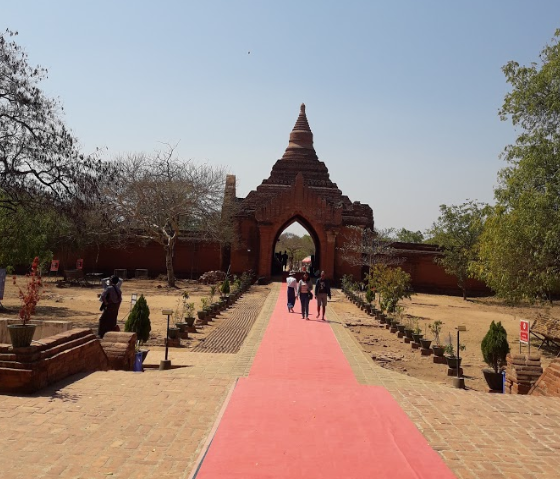Sulamani temple is located south-west of Bagan in Minnanthu village. It is one of the most visited temple in Bagan and has beautiful frescos.
The two storey temple has a ground floor and a smaller upper floor. There are three receding terraces on the ground floor and four in the upper floor. The corners of all terraces have small square stupas. The upper floor is topped by a shikhara on which is the hti.
It suffered heavy damages during earthquakes. The damage of 1975 eathquake was restored, but again in 2016, the shikhara was badly damaged. It was being renovated when we visited the place in March 2019.
It suffered heavy damages during earthquakes. The damage of 1975 eathquake was restored, but again in 2016, the shikhara was badly damaged. It was being renovated when we visited the place in March 2019.
The top of temple is shikhar type but unlike Ananda is not gilded, on top of which is hti, an umbrella shaped ornament.
History of temple:
 temple murals
temple murals
slightly faded mural showing Buddha with disciples on his sides and monks below with alms bowls
History of temple:

information stone outside the temple tells how Narpatisithu found a ruby and built the temple at that place.
information in Burmese
King Narpatisithu apart from constructing this temple in 1183, also built Dhammayazika and Gawdawpalin. Not surprising that Htilominlo (son of Narpatisithu) built Htilominlo temple which reflects shades of Sulamani temple which was built later in 1218.
The lower floor is larger in area, but the height of both the floors is same which gives a complete balance to the structure.
After the temple suffered heavy destruction in 1975 earthquake, access to upper floor has been prohibited.
entrance to temple premises through this arched gate, picture taken from inside
east entrance to temple with flaming pediment
beautiful stucco work near entrance
two kalmukha together, where arrow points
temple guardian on one side
Placing or painting a temple guardian protects not only the temple, but also those visiting the place.
fresco on ceiling
golden seated Buddha on eastern entrance
Buddha image with chatra or umbrella
Buddha sits in Bhumisparsh mudra, or the earth-touching pose with right hand touching bhumi or earth. The pose represents of Buddha's awakening as the earth witnesses his enlightenment.
There are porches on all four sides, but the one in eastern side juts out a little. This seemed a regular feature in most temple where the east side projects out more. There are golden Buddha images on the ground floor on four sides.
mural paintings between archwaysThere are porches on all four sides, but the one in eastern side juts out a little. This seemed a regular feature in most temple where the east side projects out more. There are golden Buddha images on the ground floor on four sides.
As you can visualize, a corridor runs all around on the ground floor interrupted on four sides with an entrance where there are seated Buddha images on a pedestal.
Buddha image between two archwaysBuddha image with chatra or umbrella
In the above picture, Lord Buddha is seated in bhumisparshmudra under an umbrella in a deeply recessed alcove and symbolizing the enlightenment and the First Week. It is said that in his first week, he sat at the foot of Bodhi tree. The umbrella probably symbolizes enlightenment.
The enormous brick image has been restored and painted many times.
Buddha spent his last seven weeks near the Bodhi tree under which he got enlightenment.
Buddha sitting on a lotus, beautiful fresco behind the image
Buddha on a pedestal
Frescos at temple:
Sulamani temple has one of the best and well maintained frescos to appreciate.
disciple with flowers
reclining Buddha on wall
Like other temples, Sulamani temple too has Buddha images in interconnecting corridor.
The inner walls of temple corridor in the lower floor has remarkable frescos and murals all around. They have been restored in 1994. On the south end of temple, the paintings are damaged. The temple lets in enough light to appreciate the beauty of frescos.
iron grills placed in front of wall to protect from damage by hands touching the wallsLeft part of the above picture shows Mucilinda, the Naga king protecting the Buddha from pouring rain.
reclining Buddha mural on wall in one of the corridor, seated Buddha on side
the painting here looks very different, seems an emaciated Buddha
very faded mural
looks like a beautiful piece of art, but the plaster has fallen off
inscription stone
This stone slab in the north portico of temple explains how King Narapatisithu found a ruby at the place where this temple was later built.
somewhat faded painting
very fine but faded elephant painting with ink incription on side, near his head
kalmukha
kalmukha and lotus flowers on sides
The brickwork throughout the temple is considered one of the best in Bagan. At the base are visible niches where plaques were placed depicting Jataka Tales (stories about the previous lives of Lord Buddha). Either the plaques have worn out with time or broken but now you see only empty spaces.lotus bud at the flaming pediment
The side wall on outside near the entrance show very fine carved stucco. Down in the picture is seen kalmukha.
The other side of temple with no entry arched gate
The temple has entrances from all four sides, but eastern side is the main entrance. A must visit temple with intact and very well preserved and beautiful murals and fresco.


















































No comments:
Post a Comment
Thanks for visiting my blog. Your feedback is always appreciated.